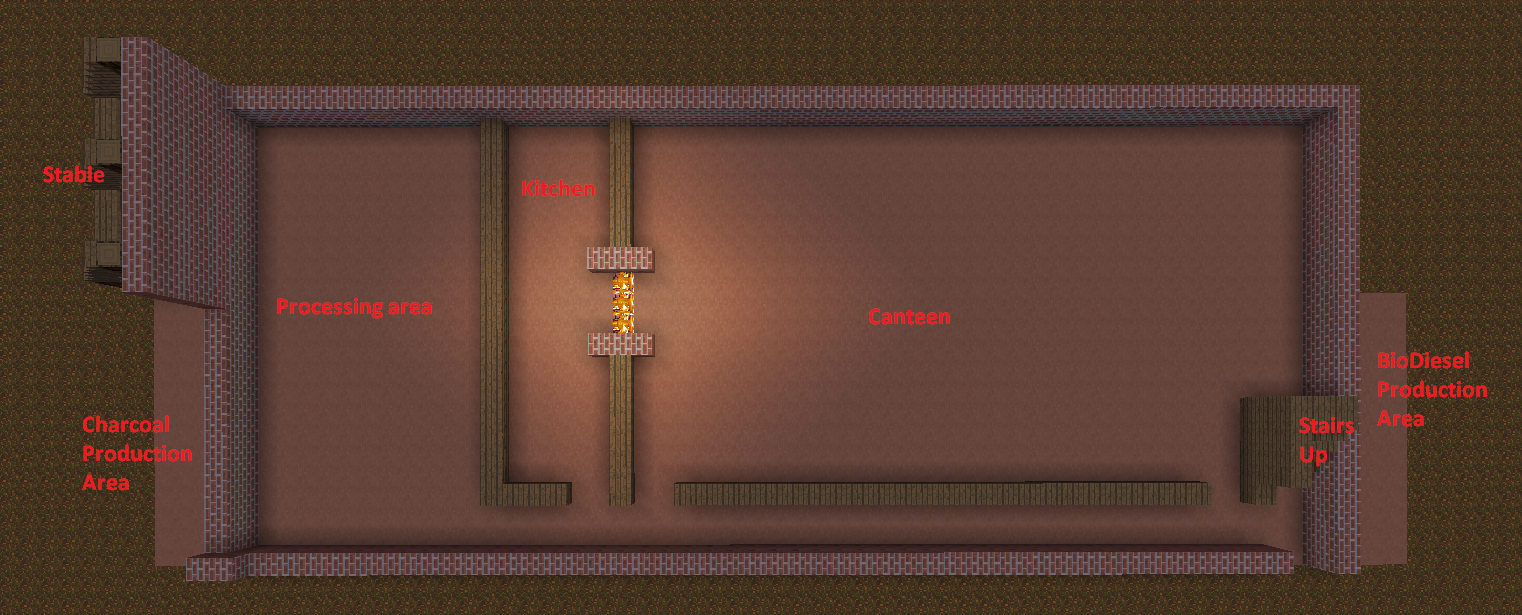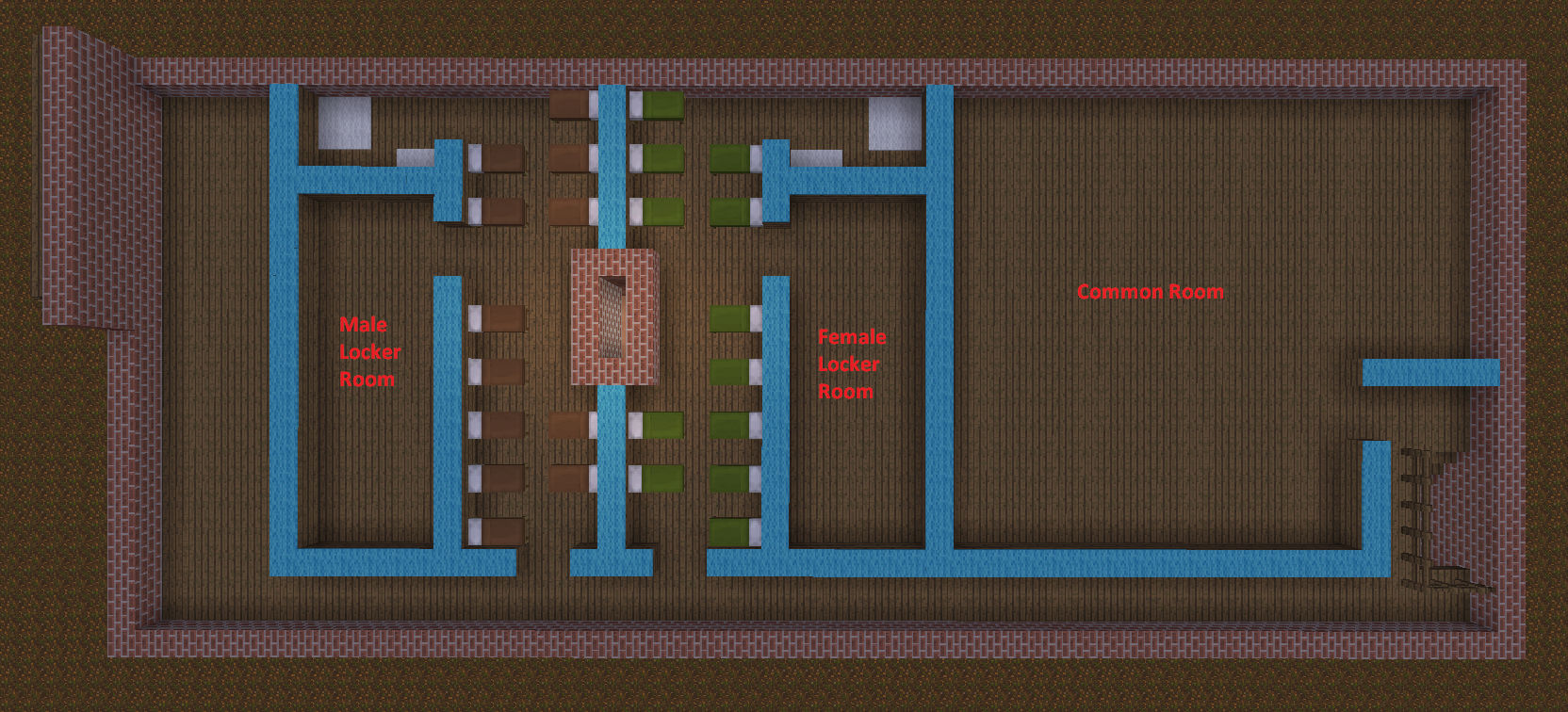Forestry: Buildings
Buildings Involved In The Industry
Lodge
Lower Floor |
Upper Floor |
To see the images in full screen, please right-click the image and select "Open image in new tab"
This is the main bricked building of the forestry industry and it is where the workers live, work and eat. Although it is not where the sawmill workers live as they have their own accommodations. The lodge has an upper and lower floor with no basement, there are several rooms detailed below.
Common Room
This is the first room that a person will find on the upper floor of the lodge, this is a place where people will meet before and after their work, including in the evenings if they don’t wish to go into the city of Birdencaster. In the evenings they will either chat or play games together, such as Sixes: The Dice Game.Bunkhouse
The second most room to be found on the upper floor of the lodge is where the workers sleep. Sleeping areas are separated into Male and Female, each has a locker room to change into the clothes of their job as well as cubicle showers to wash.Kitchen
The kitchen is where obviously the meals of the workers are made. The meals themselves are seasonal by temperature in nature and hearty. The portions of food depend on the person's job as if they work hard and physically they will require more food to be sated. Seasonal food includes but is not limited to, for breakfast porridge for colder weather while in warmer they might have a fried breakfast. For lunch, when it’s colder it is more than likely bread and a thick soup of some kind. While warmer temperature bread and cheese may be given. The evening meal could be a stew of some kind in winter months and something filling for summer months. While the meals are varied a balanced diet is still paramount as with a healthy workforce you tend to have a productive workforce. It is believed at this point that food is an essential thing so to be picky with one’s intake of meals is not a good idea. As such any dietary word to describe someone is generally in historical context. This is not to say people have food allergies, they do. That is a more valid reason rather than having dietary limitations by choice. The terms for dietary requirements like pescatarian, vegetarian and vegan for example are still in the dictionary but are labelled as historic, as food is limited but does come in fewer varieties and choices. If someone comes from a city that doesn’t have an Animal Husbandry industry they will get their meat from cans rather than having a choice, such as in Birdencaster . People with optional dietary requirements that aren’t allergy problems will suffer from malnutrition, it is recommended to have a whole range of foods.Canteen
In the canteen is where people have their meals. The tables they sit at would be described as long tavern-style tables and they sit on benches. The benches are laid out in long rows not facing the fireplace. Meals aren’t handed out by the kitchen staff walking out from the kitchen and handing workers food while they sit, rather they queue by a hatch and are given meals through that, once finished they leave their crockery and cutlery behind.Processing Room
It is in the Processing Room that pine needles are harvested from their twigs and processed into either baskets or for export to make paper [5]. It is also the room where trug baskets are made and tools are sharpened and maintained. And pine cones are processed to pine saplings. This room has no door as the room is often busy and it would be inconvenient to have a door be used frequently with people working in the room. There are shelves on the wall for items that would help with sharpening and maintaining tools. These are whetstones that measure 12 cm x 7 cm x 3 cm (4.72 in x 2.76 in x 1.18 in) and are cuboid in shape when new as they wear down as a tool is sharpened. Since the whetstones come in different grits the number of grit are painted on the smallest side. When the whetstone is put back on the shelf the number points out so it can easily be identified for ease of use. Pliers are also kept so that the teeth of the saw can be adjusted. In autumn pine cones that are more 5 cm (1.97 in) wide and 6 cm (2.36 in) tall are gathered. If the pine cone scales are closed, they are kept somewhere warm so that they open and the cone is left for a week on a tray. After opening so the pine seeds separate as the pine cone will assume it is a hot month and open up and release its seeds. Once this happens the seeds go into moist sandbags to germinate. When they do they are put into pots. As soon as the sapling reaches 15.24 cm (6 in). The sapling is planted, it will take 9 years for the sapling to reach maturity for the process to restart, and the tree to be felled. The sapling doesn’t require a tree guard unless it is planted more in the wilderness. Most areas are fenced off so wild animals or the deer from the Animal Husbandry industry don't eat the saplings. For carriers, they carry a knife just in case a wolf or other wild animal sees a chance for a meal.Charcoal Production Area
On the outside at the far end next to the stable, sits the Charcoal processing area. In this area, they process wood chips and kindling to charcoal. This is done by cooking the wood rather than burning it [7]. Once the steam of the chimney of the charcoal kiln goes from white to blue they end the process. As they would at this point be burning the product they want. This charcoal supplies the metalsmiths and steel mills with what they need in their forges. This area has a kiln for this process. Once the charcoal has been made, it is sieved to grade the size of the charcoal. The large chunks that don't make it through the sieve are bagged and go to the Warehouses to be sold to metalsmiths and steel mill. The smaller chunks are used by the lodge to heat and cook food by.Biodiesel Production Area
On the opposite side to the charcoal production area sits the Biodiesel Production Area. This area is used to produce biodiesel for portable sawmills. They do not produce nearly enough fuel so that everyone in Birdencaster can Use the supply. It has health concerns when using it in a place that is not open or ventilated. It is considered safe to use in the forestry industry. The biodiesel is derived from used cooking oil [1a] which is then added to a barrel in the area when it gets to a usable level, as people who own restaurants or places that would have used cooking oil donate this to them. Once this occurs a litre is drawn off and filtered to remove, mysterious bits, from the oil, then 30 ml of white spirit is added. As the ratio for biodiesel is for every 97 ml of oil, 3ml of white spirit needs to be added. When this is done the mixture is left to sit in the other 60-litre barrel for 1 week and emptied into a 20-litre jerry can. If before leaving the biodiesel for a week, the second barrel is not full, the process of drawing off a litre and adding 30ml resumes until a complete litre can't be added without extra being left. They do it in litre batches for accuracy concerns.Sawmill
The sawmill can be found in Segment 12. Can be seen from outside the city’s limits as it is accessible from both the forested side as well as the city side. It is in the sawmill that planks, boards, posts and beams are finished, finalised and graded. The wood products are finished off in this building as the portable sawmill cuts the wood products from an unfinished log, so the wood products may have bark. With posts and beams, they are cut to length as they already have no bark. Once cut to length they are treated with copper azole to preserve the pine from the elements [6]. The boards and planks have their width reduced as to remove the bark and the cut-offs from this are further broken up as to make the offcuts easier to transport. The boards and planks are then up to length and either treated if they are intended for outside use.Article Contents
Further Resources
Forum post on portable mill fuel efficiencyA Wikipedia Category Article on Forestry Tools
A Youtube video on making diesel from old chip oil.
References
[1a] Vegetable Oil for Diesel | Top Gear[5] Material District.com on Pine Needle Paper
Youtube video - Time Team - Season 9 Episode 5
[6] Wikipedia article section on Pine being used in construction
[7] Youtube video - Time Team - Season 9 Episode 5
With thanks to Minecraft to make images.
Acknowledgements
Author Goddess
Author Goddess's World Anvil Author Page
Twitch
Dazzlikat
Dazzlikat's World Anvil Author Page
ErinRigh
Erin's World Anvil Author Page
SableAradia
Sable's World Anvil Author Page
Twitch
Siobhan The Writer
SiobhantheWriter's World Anvil Author Page
Twitch




